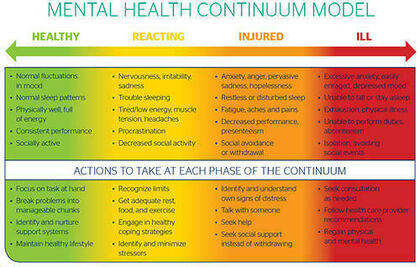Article
Building a Culture that Supports Mental Health
May 21, 2024
In the years since I published Your Oxygen Mask First, I’ve been involved in many conversations about mental health resilience, and how to create cultures that help people to thrive in good times and bad.
One of the most effective tools is the Mental Health Continuum model, used by mental health associations around the world.
The essence of this easy, non-judgemental colour-coded model, is to help people to assess their mental health and spot warning signs quickly.

Green, Yellow, Orange, Red
The best explanation of the model came to me in a mental health course. If we sprained an ankle, we’d go to physiotherapist. If we broke an ankle, we’d go to a doctor or the hospital to get it set. If we broke multiple bones, we’d go to the ER for surgery and rehab to help us heal.
Each of those situations relate to the different intensity shifts we could have in our mental health, in increasingly challenging situations – from green to yellow to orange to red.
But it’s just not as natural a reflex for us to go to a brain doctor as it would be an orthopedic surgeon when we break a bone.
A Common Language
Many organizations have adopted the Mental Health Continuum model because it gives us a common language and understanding of mental health on our wellbeing and performance. It provides the grounding to have a neutral conversation, without disclosing the actual problem, in case someone wants privacy or is shy or proud.
You can say, “I think I might have slipped into the orange zone” so that people can provide support to help you get back into the green zone.
An executive and I recently talked about somebody in their company who was in a really challenging phase. When he said the person was in the red zone, we both knew what that meant, and could have a conversation about how to help them.
In our own firm, we use the model as part of our quarterly surveys, to check in on the team’s mental health, and to see how we can give and receive support – and to celebrate when things are going well.
It’s the best way I know to acknowledge and normalize what can be sensitive and complicated issues in any company.
The Challenge
- What can you do to make it easier for people to openly talk about and mental health and to get the assistance they need?
Resources
Your Oxygen Mask First. Here are links to two chapters you may find useful:
- Chapter 3 Double Your Resilience
- Chapter 7 Manage Your Mental Health
Articles
- Managing Your Mental Health in Turbulent Times
- Taking a Mental Health Break
- Is Mental & Emotional Health a Priority in Your Boardroom?
- Teach Your Children Mental Resilience
- Get Moving: The First Option to Treat Depression & Anxiety
Assessment Tool
9−8−8 hotline for mental health and suicide prevention support.
Free, 24 hours a day, seven days a week, 365 days a year. Trained crisis responders will listen to you and provide support with compassion, and a safe space to talk.
An interview with one of us who had a close call.
About Lawrence & Co.
Lawrence & Co. is a growth strategy and leadership advisory firm that helps mid-market companies achieve lasting, reliable growth. Our Growth Management System turns 30 years of experience into practical steps that drive clarity, alignment, and performance—so leaders can grow faster, with less friction, and greater confidence.
About Kevin Lawrence
Kevin Lawrence has spent three decades helping companies scale from tens of millions to hundreds of millions in revenue. He works side-by-side with CEOs and leadership teams across North America, the Middle East, Asia, Australia, and Europe, bringing real-world insights from hands-on experience. Kevin is the author of Your Oxygen Mask First, a book of 17 habits to help high-performing leaders grow sustainably while protecting their mental health and resilience. He also contributed to Scaling Up (Rockefeller Habits 2.0). Based in Vancouver, he leads Lawrence & Co, a boutique firm of growth advisors.